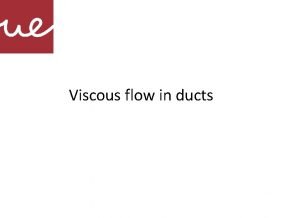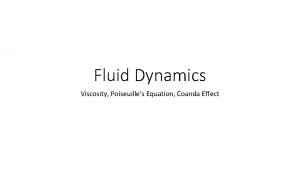FLOW OF PURELY VISCOUS NONNEWTONIAN FLUIDS IN STRAIGHT

- Slides: 1

FLOW OF PURELY VISCOUS NON-NEWTONIAN FLUIDS IN STRAIGHT NON-CIRCULAR DUCTS: A REVIEW AND COMPARISON OF PROCEDURES FOR RAPID ENGINEERING FRICTION FACTOR ESTIMATES JIŘÍ ŠESTÁK, RUDOLF ŽITNÝ AND MARTIN DOSTÁL Czech Technical University in Prague – Faculty of Mechanical Engineering, Institute of Process Engineering, Technická 4, 166 07 Prague 6, Czech Republic sestak@fsid. cvut. cz Review and comparison of approximate methods for rapid estimates of the Fanning friction factor f for stabilized flow of purely viscous fluids in non-circular ducts. Results for the particular case of a power-law fluid, are compared with data obtained by numerical integration. Miller Delplace Kozicki Liu Two shape factors a, b error < 15% L-shaped cross-section singly connected region error < 5% W. Kozicki, C. H. Chou, and C. Tiu, Chem. Eng. Sci. (1966) 21 665 -679. J. Šesták, Can. J. Chem. Engng. (1974) 52 670 -672. . C. Miller, I. & E. C. Fundam. (1972) 11 524 -528. . F. Delplace and J. C. Leuliet, Chem. Eng. Journal, (1995) 56 33 -37. . S. Liu, and J. H. Masliyah, Chem. Eng. Sci. (1998) 53 1175 -1201. J. Šesták, R. Žitný and J. Bukovský, in "Proceedings XIIth Int. Congr. on Rheology", (Ed. A. Aďt-Kadi et al. ) Canadian Rheology Group, Montreal (1996) p. 386. . T. J. Liu, I. & E. C. Fundam. (1983) 22 183 -186. N. A. V. Piercy, M. S. Hooper, and H. F. Winny, London Edinburgh Dublin Phil. Mag. J. Sci. (1933) 15 , 647 -676. . T. L. Guckes, Trans. ASME, J. Eng. Industry (1975) 97 498 -506. . J. Šesták, R. Žitný and J. Bukovský, in "Compact Heat Exchangers and Enhancement Technology for the Process Industries", (Ed. R. K. Shah) Begell House, Inc. , New York (1999), pp. 107 -111. CONCLUDING REMARKS For cross sections formed by singly connected regions and values of f Re/16 differing not much from unity, all four approximate procedures yield useful results with errors usually below 5%. From the point of view of computational effort, Delplace and Leuliet’s method may be recommended giving results with acceptable accuracy and just a single shape factor (a+b). For cross sections formed by multiply connected regions, especially those exhibiting very sharp corners (such as in the gap of the annular geometry for e* 1), neither of the methods available so far can be recommended and further work is needed.

